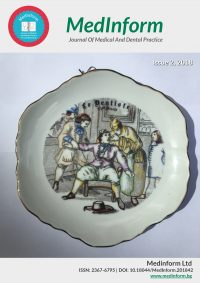Issue Two 2018
2018, Vol. 5 issue 2, (June)
Original Article
A case of anaplastic liver cancer after HCV eradication with IFN- free therapy
Abstract:
Introduction
Hepatocellular carcinoma (HCC) represents more than 90% of primary liver cancers and is a major global health problem. In the era of Direct acting agents (DAA) for treatment of hepatitis C virus (HCV), sustained virological response (SVR) is achieved in more than 80% of cases. Accumulating clinical experience of DAA-based treatment has suggested that post-SVR HCC development and recurrence may be more frequent compared to interferon (IFN)-based treatment. We describe a case of poor differentiated HCC in non-cirrhotic liver, after HCV–eradication.
Case presentation:
A 73-year-old female presented with HCV-hepatitis at the beginning of 2017. A liver biopsy showed low grade fibrosis (F1). HCV genotype was 1b, with viral load 680 500 IU/ml.
She was anti-HBc total positive, but negative for hepatitis B surface antigen (HBsAg) and HBV DNA – negative, and also anti-HIV 1/2 and had no history of alcohol or drug abuse.
In May 2017 – treatment with IFN-free regime was started – 3D – Viekirax and Exviera, without Ribavirin. At the 4th week of treatment HCV RNA was negative. At the 12th week abdominal ultrasound (US) showed a 60 mm liver nodule in 6th segment and a few more nodules form 10 to 32 mm. AFP was slightly elevated (59 ng/ml).
The contrast enhanced computed tomography (CT) scan showed typical signs of HCC. Ultra sound (US)-guided biopsy was performed. Histological result was: Anaplastic carcinoma with stromal desmoplasia and expressed lymphocyte stromal reaction (a liver origin is possible). Immunohistochemistry test showed: Alpha-feto protein – negative reaction; Ca 19-9 – negative reaction, but Ki67 – 40% proliferative activity. The patient was at stage B according to Barcelona-clinic liver cancer (BCLC) classification and treatment with Sorafenib was started.
Discussion:
Sequence of chronic hepatitis – cirrhosis – HCC is well known. In these cases the major role in oncogenesis is due to severe fibrosis and inflammation. HCC in non-cirrhotic liver is not well understood.
The oncogenic potential of core protein of HCV has been discussed and therefore HCV is directly involved in hepatocarcinogenesis. Recent studies show higher frequency of HCC in patients with 1b HCV infection. In presented case – the patient was infected with HCV subgenotype 1b and had very low stage of fibrosis. But she was anti HBcor –positive and after HCV eradication. Several studies suggested a possibly distinct difference in host immune modulation between interferon and DAAs.
Because of multiple character of HCC (more than 3 nodule, exactly 7 in this case), the initial treatment was Sorafenib. It was well tolerated and resent CT showed only two nodules. In this stage a RFTA is discussing.
Authors:
Nina Nikolova; Univercity Hospital Acibadem City Clinic Oncology center, Clinic of Gastroenterology;Stoyan Handzhiev; Univercity Hospital Acibadem City Clinic Oncology center, Clinic of Gastroenterology;
Dimitar Petrov; Univercity Hospital Acibadem City Clinic Oncology center, Clinic of Gastroenterology;
Alexander Marinov; Univercity Hospital Acibadem City Clinic Oncology center, Clinic of Gastroenterology;

